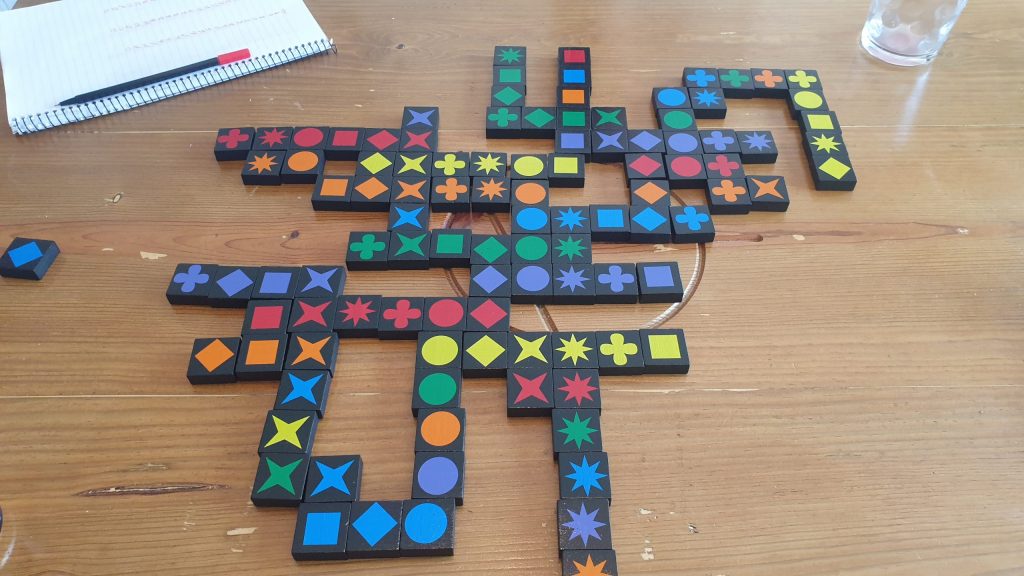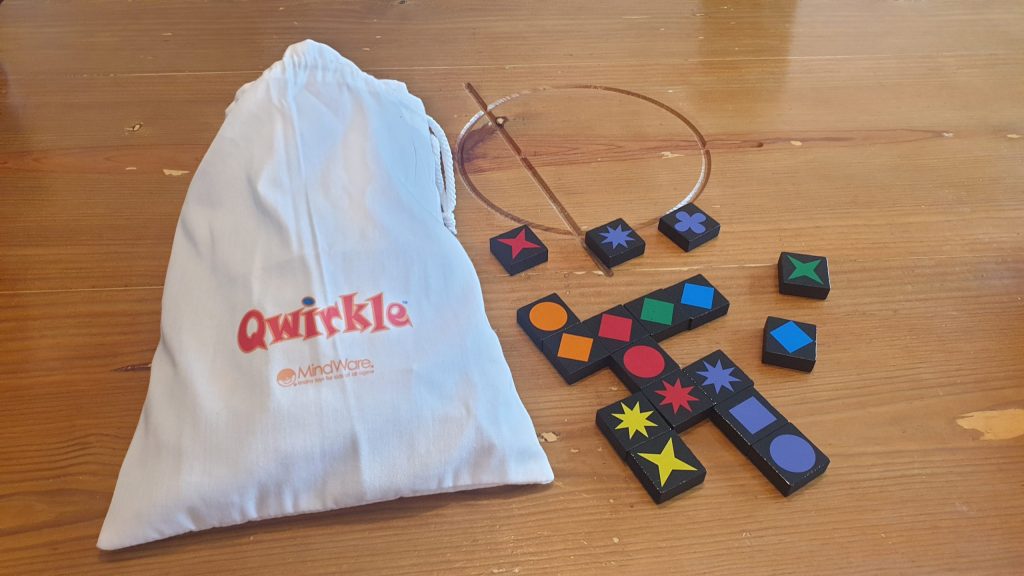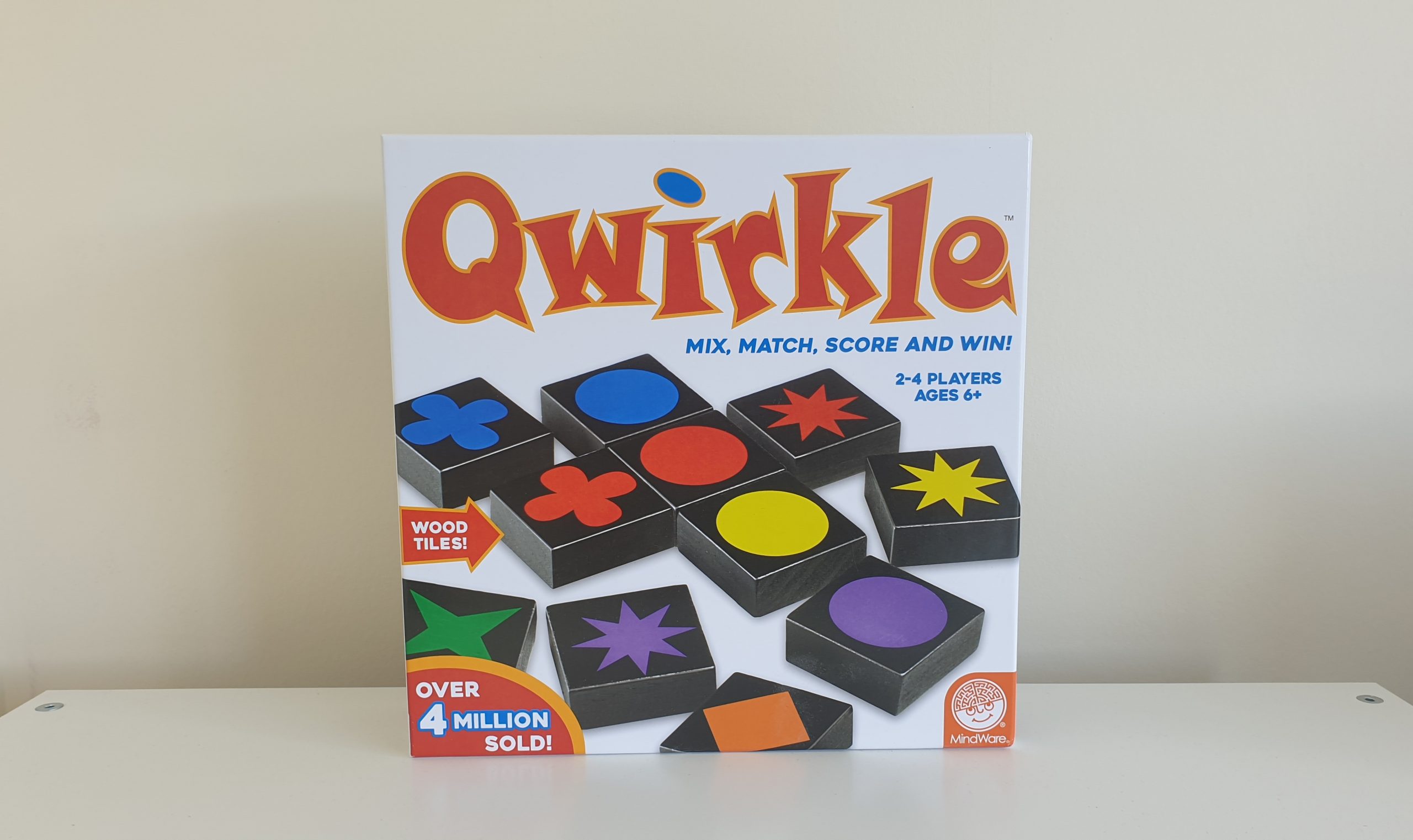Qwirkle is a simple abstract strategy and pattern building board game from publisher MindWare. Designed by Susan McKinley Ross, Qwirkle is for 2 – 4 players and plays in around half an hour. Coming with wooden tiles, this is a game about matching colours or shapes in an effort to score maximum points. However, will the game make you shout Qwirkle or shout at it? Let’s find out!
Aside from grabbing a pen and paper to score, setup is as simple as each player drawing 6 tiles from the drawstring bag. Looking at their tiles the players determine whom will go first. The player with the biggest set of non-identical tiles with either matching colour or shape, but not both, starts the game by playing them into the middle of the table. Throughout the game players will then take it in turns adding tiles adjacent to those already in play in an effort to score points.
All placements must follow two rules. Firstly, two tiles of the same shape and colour cannot be in the same row. Secondly, each row can only contain tiles of the same colour or shape. Adding tiles to the board scores points based on the number of tiles in the rows. For example, adding a yellow square and yellow circle on the end of a yellow star would score three points. It is possible to play a row of tiles perpendicular on the end of an existing row, which sees both rows scored. If a player manages to place tiles so that a row has either every colour or every shape in it, which is referred to as a Qwirkle, 6 bonus points are scored.
If a player cannot or chooses not to place tiles their turn they must instead discard tiles from their hand. At the end of a turn, regardless of how tiles were used, players draw back up to a full hand of 6 tiles. In the final few rounds of the game the bag will empty, at this point players simply skip the redrawing phase. The end of the game triggers as soon as someone places their last tile, and that player scores a bonus 6 points for doing so. Whomever has the highest score at this point is crowned the winner.

Aimed at anyone from family weight upwards, Qwirkle is simple to play. There is no barrier of entry, helping the game get to the table quickly – regardless of if everyone has played before or not. While everyone is grabbing tiles from the bag there is enough time to explain all the rules. However, it can be helpful for new players to be shown an example or two, though this only slows the game starting by around a minute.
After one or two plays the game does evolve past just the simple puzzle that initially presents itself. It is as much about saving up for Qwirkle combos and trying to deduce where opponents are eyeing up, than just playing the odd tile here and there. The biggest sign of this is how discarding tiles on a turn, effectively making it a no scoring turn, in the first game seemed counterintuitive. It is however a great way to churn the tiles of the bag and obtain the colours or shapes needed.
Without a tracker of any kind, one player is resigned to playing and keeping score. In a game where you often want to make quick and snappy moves, the need to constantly be scoring can slow the experience down. This is especially the case when the player who is in charge of scoring gets a go – as they aren’t spending time between their turns working out where they could go. Make this player someone that has played before and it is less of an issue. Just bear in mind, during an initial play, it is best not to make the scorer someone that really ponders each turn.

All 108 tiles are always used, even if they are only used to clog up a hand before being discarded. There are a couple of consistencies that this causes, from one game to the next. The game length is the first, with it consistently hitting around the 35 minute mark, so there aren’t games which are over in a flash and neither will you find it dragging on. Also, there is the knowledge that in that drawstring bag, or other players hands, there are always 3 of each shape colour combination. It isn’t exactly card counting levels of play but it is possible to calculate if specific Qwirkle opportunities are still possible.
Aside from missing some kind of score tracker, or a pen and paper to score on, the components are top quality. The tiles are thick wooden blocks. Not only does this make the game feel substantial it means it is far from fiddly to place the tiles. The large drawstring bag is also a great touch, making the game rather portable if players wanted to take the game out and about – though a decent sized flat surface is needed for play.
Qwirkle may offer simple gameplay, yet it manages to do this whilst giving players choice on each and every turn. There is a satisfaction to scoring big, even when it comes from having the right shape to score the bonus Qwirkle points. There is a bit of luck in the game from what is drawn from the bag, though it never gets to the state where someone has won solely off what they’ve drawn. They still need to play tiles in the right combinations and places. Qwirkle is one of those games you can enjoy while chatting with those around the table. For that reason, while the box might go, Qwirkle’s drawstring bag will stay on my gaming shelf!
(Editor’s Note: Qwirkle was provided to us by Coiledspring Games for the review. Check out the game’s official webpage here.)

